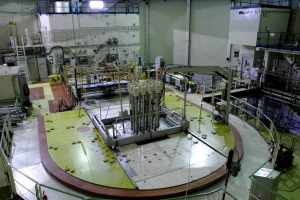Licence to operate MARIA research reactor renewed for 10 years
09-04-2015
NCBJ’s licence to operate the MARIA research reactor was renewed by Polish National Atomic Energy Agency (PAA) for another period of 10 years. The licence has confirmed that the reactor is operated in line with the highest safety standards.
Licence to operate MARIA, the sole research reactor in Poland, was renewed at the beginning of April 2015 for another period of 10 years. PAA (regulatory oversight body that issued the licence) has confirmed that the reactor has been operated according to all applicable international quality standards, and in line with the highest standards concerning radiological safety.
„The previous licence was issued in 2009. Since that time many positive changes – some of them rather essential – have been introduced to our reactor.” – pointed out Eng. Grzegorz Krzysztoszek, MSc, NCBJ Nuclear Energy Department Director – „First of all, our participation in the Global Threat Reduction Initiative programme helped us to replace key elements of the reactor. To-day, after a long process of making indispensable preparations, implementing modernization works, and testing the outcomes, we routinely run the reactor on low-enriched fuel (containing less than 20% of uranium 235). The operation of switching the reactor to a low-enriched fuel was rather complicated. However, no essential operational parameter of the reactor has deteriorated in the process, moreover we have managed to boost annual working hours of the reactor up to 4,800 h. That way our potential has significantly increased, both in the research area and in the radioisotope production area”.
Even if MARIA has been producing radioisotopes for many years, an essential breakthrough occurred only in 2010. That time we started to irradiate uranium targets to produce molibdenum-99, which decays to technetium-99. The latter radioisotope is extremely important for nuclear medicine: it is employed in 80% of all procedures applied in cancer therapy all over the world. Our reactor is one of just a few facilities in the world that produce molibdenum-99. Just one week of its operation is enough to produce radiopharmaceuticals sufficient for 100,000 patients of oncology clinics. NCBJ’s reactor was responsible for 18% of world supplies of technetium-99 within the last year. Our scientists are working hard to further boost MARIA’s production capabilities and to diversify our offer.
However, MARIA’s mission is not limited to production of radioisotopes for nuclear medicine. The reactor is a source of intense neutron fluxes. Neutrons are electrically neutral particles strongly bound within nuclei. Free neutrons are not repelled by Coulomb barriers when interacting with other nuclei. They yield to all four known physical forces (strong, electromagnetic, weak, gravitation). All in all, properties of neutrons are still extremely interesting for physicists. MARIA is a source of neutrons in many research projects such as neutron modification of materials, BNCT cancer therapy, radiation resistant constructional materials for 4th generation fission/future fusion power reactors. Świerk scientists help their French colleagues to determine precision of software codes used to calculated gamma heating effects in Jules Horowitz Reactor (JHR) under construction in w Cadarache. MARIA is also all the time used to train personnel for future nuclear power industry in Poland, and experts in radiological safety and radiation protection. Each year almost 7,000 high school students visit the Świerk reactor within the framework of activities aimed to popularize the sciences among school youth.
„Undoubtedly, MARIA is our precious asset. After we had demonstrated in previous years our competences in designing, constructing and operating such facilities, recently we became a significant partner in the international arena” – said Professor Grzegorz Wrochna, NCBJ Director General – „Our unique capabilities allowed us to reach an agreement with CEA, our French counterpart, in the matter of a jointly run Centre of Excellence. That agreement signed during a recent visit of French Prime Minister to Poland may become a key element of development of power industry of the future.”
***
MARIA, the largest nuclear reactor in Polish history and currently the sole reactor operated in Poland, reached its critical state for the first time on December 17, 1974. That date is presently taken as its birthday. MARIA was initially to increase research potential of EWA, the first research reactor ever operated in Poland (de-commissioned in 1995). MARIA was thoroughly modernized in 1985 and became an R&D support for the first Polish nuclear power plant then under construction in Żarnowiec. To-day its rated power amounts to 30 MW and it finds multitude of other applications.
MARIA design of the channel/pool type is rather unusual. Fuel rods and other elements of the reactor core (beryllium moderator blocks, graphite reflector blocks, control rods, containers with the to-be-irradiated targets) are kept together by the so-called core basket placed under a 7-metres thick layer of water within the reactor pool. Another adjacent pool separated by a water lock plays the role of a short-term storage facility for spent fuel, irradiated constructional elements and materials. Core construction is modular, so that the core may be quickly, easily and safely adapted to changes in the research or production programme. External experiments may be run at six horizontal channels through which neutron beams exit the core.
MARIA is equipped with a number of safety-related facilities: cooling loops, ventilation systems, start-up/power-up interlocks, emergency core flooding system, multistage power supplies that guarantee uninterruptible power supply both in operational conditions and in emergencies, reactor waste processing systems, special radioactive waste management, extended dosimetric system (continuous monitoring of radiation fields and radiologic exposition). Evaluation of the technical state indicate that MARIA may be operated until 2020. Suitable modernization carried out after that period might extend lifetime of the reactor until 2060.
Poland has 60 years of experience in building/operating nuclear reactors. A few critical sets/zero power reactors built in Świerk include two versions of MARYLA, ANNA, PRĘDKA ANNA (the first and so-far the only fast neutron reactor ever built in Poland), UR-100, and AGATA.





